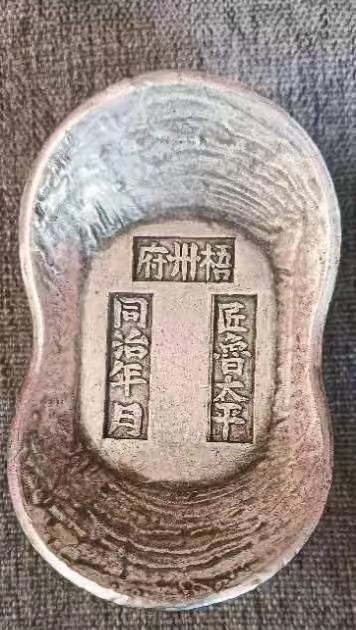该件标的为:大清同治梧洲府元宝。该件藏品重约376g.保存完整,品相一流,整体造型古朴典雅,细节处铸造也是十分考究。其铸造工艺十分复杂该件藏品浓缩了整个中华文化的铸造历史,十分珍贵,也深受藏家和各大拍卖行的喜爱。银锭是熔铸成锭的白银。出土银锭中年代最早的,是汉景帝中元二年 (公元前148年) 所铸。汉武帝元狩四年 (公元前119年) 作白金 (即白银) 三品。王莽铸有银货二品。其后历代皆有铸造,惟流通不广。隋唐以前称银锭为“银饼”、“银铤”,称扁平形银币为“钣”、“笏”、“版”,棒形的称“铤”、“挺”,宋以后改称“银锭”。元代于银锭之外总称“元宝”,形式变为马蹄形,故亦称“马蹄银”。明清两代均沿用“元宝”一词。清朝的银两多以马蹄形的元宝出现,故亦称为宝银。经过熔铸,又可分为大锭、中锭、小锭,通称银块或银锭此外还有碎银。由于各地均可自行熔铸宝银,以致宝银的种类和名称虽然全国大体一致,但成色与重量并不一律。各地使用不同成色名目的银两,相互兑换均有一定的折算比率。近年来,由于我国加大了对文化产业的重视,导致艺术品的身价水涨船高,珍稀的艺术品其市场热门度,成交率都非常不错。投资艺术品也成为众多投资者的第一选择。所以无论从收藏角度还是经济价值角度来看,该件藏品都十分值得入手
The item is marked as: Yuanbao of Wuzhou Prefecture, Tongzhi, Qing Dynasty. The collection weighs about 376g and is well preserved. Its appearance is top-notch, and its overall design is simple and elegant. The details of the casting are also very exquisite. Its casting process is very complex. This collection condenses the entire casting history of Chinese culture, is very precious, and is also loved by collectors and major auction houses. Silver ingots are white silver melted into ingots. The earliest unearthed silver ingot was cast in the second year of the Zhongyuan reign of Emperor Jing of Han (148 BC). In the fourth year of the Yuanshou reign of Emperor Wu of Han (119 BC), it was made into the third grade of platinum (i.e. silver). Wang Mang has minted second grade silver goods. Throughout subsequent dynasties, casting was used, but its circulation was not widespread. Before the Sui and Tang dynasties, silver ingots were referred to as "silver cakes" or "silver collars", flat silver coins were referred to as "sheet metal", "Hu", or "plate", and rod shaped coins were referred to as "collar" or "Ting". After the Song dynasty, they were renamed "silver ingots". In the Yuan Dynasty, it was collectively referred to as "Yuanbao" outside of silver ingots, and its form changed to a horseshoe shape, hence it is also known as "horseshoe silver". The term "yuanbao" was used in both the Ming and Qing dynasties. During the Qing Dynasty, silver often appeared as horseshoe shaped ingots, hence it is also known as precious silver. After melting and casting, it can be divided into large ingots, medium ingots, and small ingots, commonly known as silver blocks or silver ingots. In addition, there is also broken silver. Due to the fact that various regions can independently melt and cast precious silver, although the types and names of precious silver are generally consistent throughout the country, their fineness and weight are not uniform. Different regions use silver of different grades and names, and there is a certain conversion rate for exchanging them with each other. In recent years, due to China's increased emphasis on the cultural industry, the value of artworks has skyrocketed, and the market popularity and transaction rate of rare artworks are very good. Investing in art has also become the first choice for many investors. So from both a collection perspective and an economic value perspective, this collection is definitely worth buying






